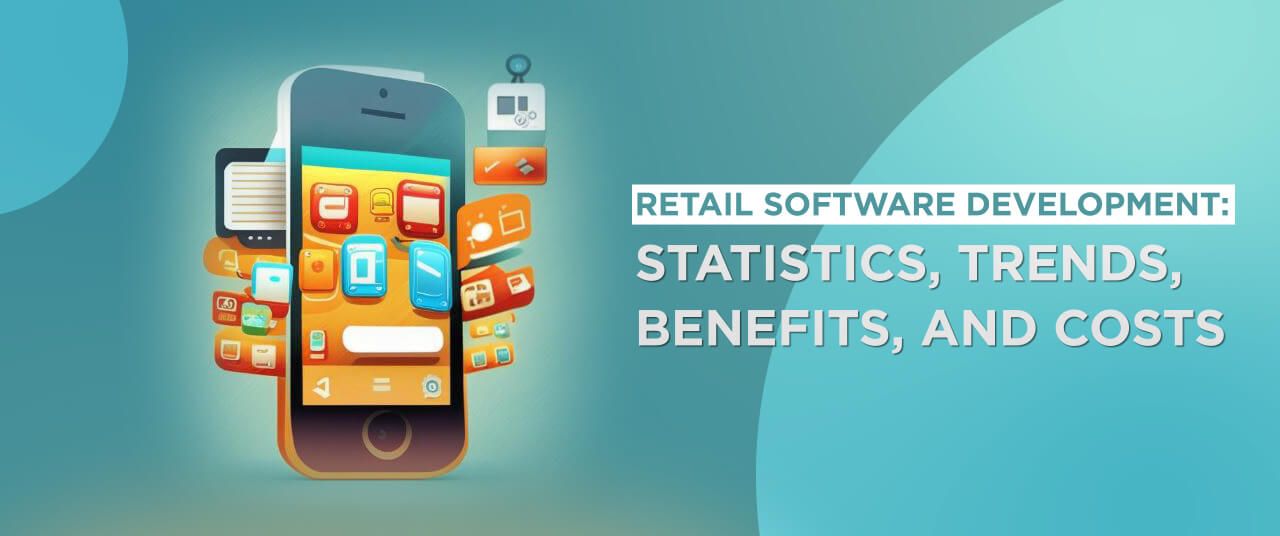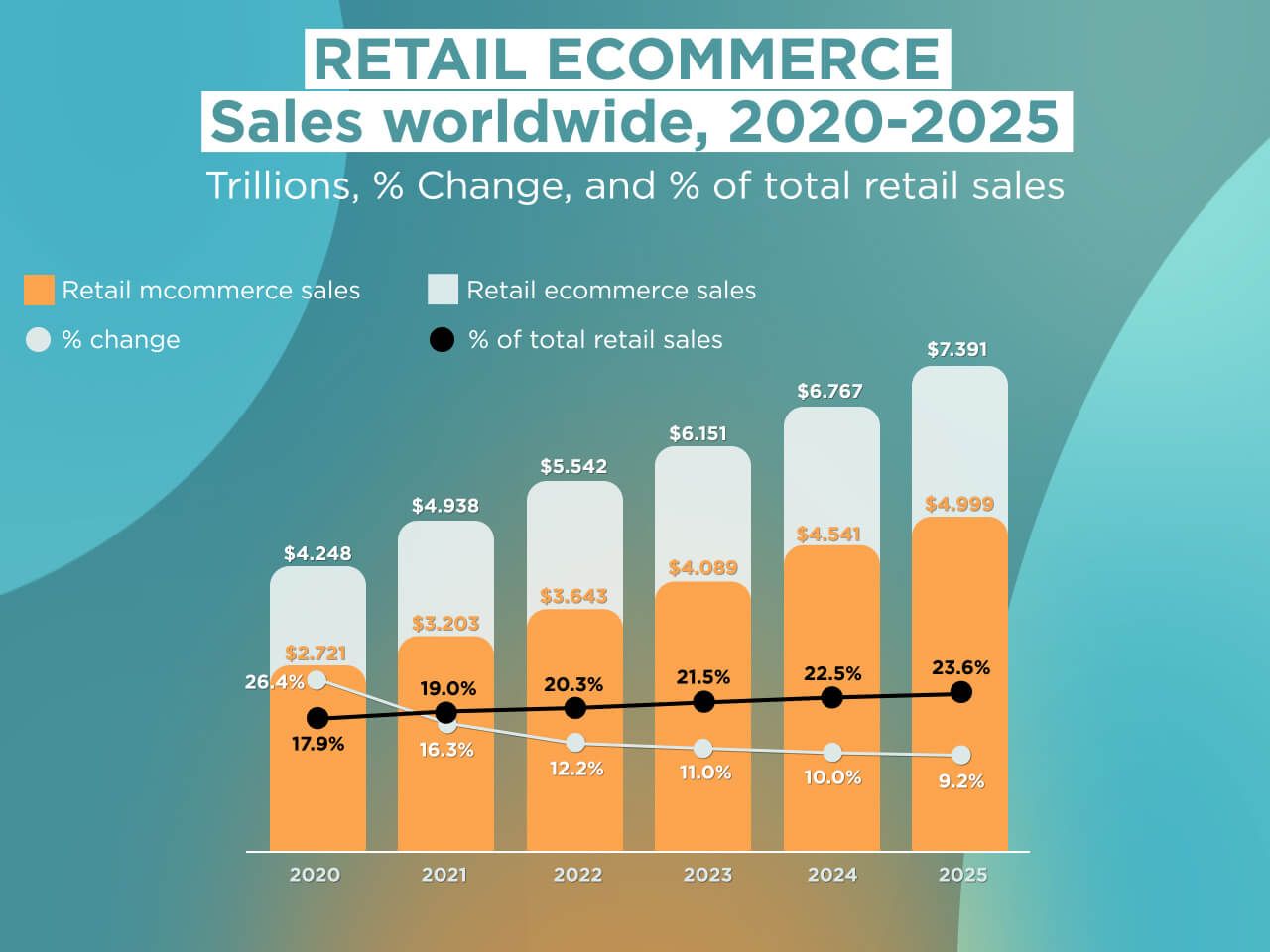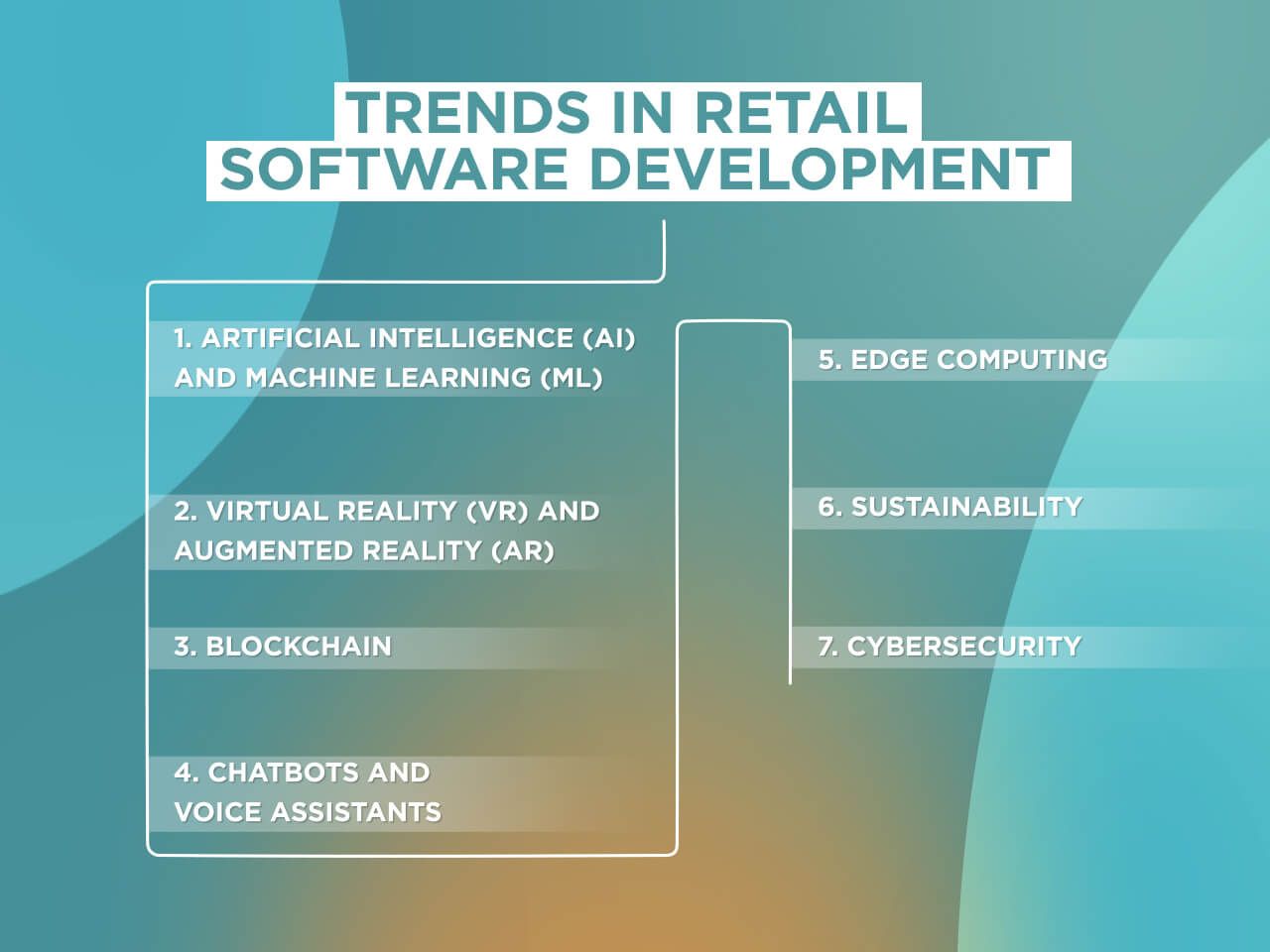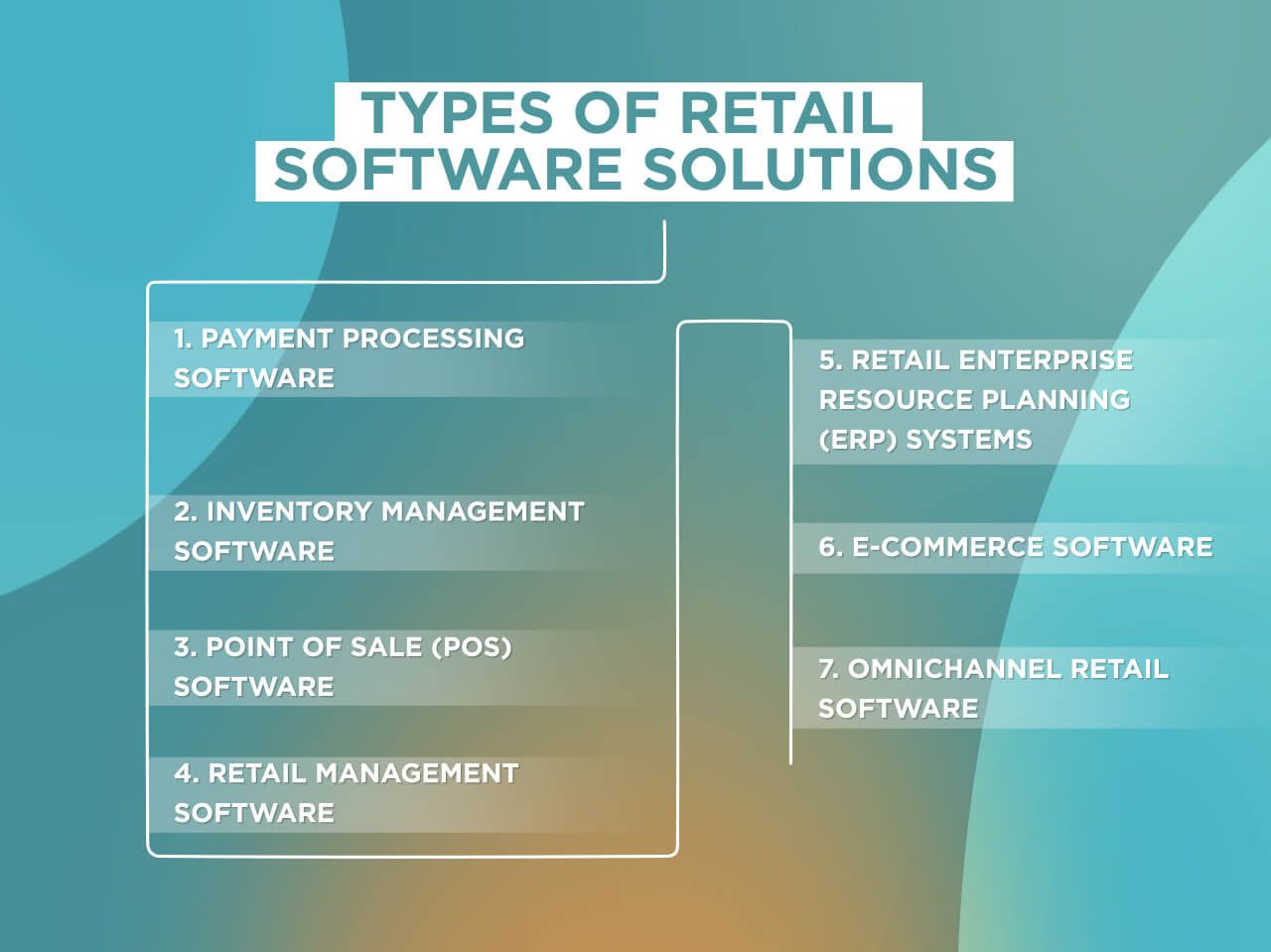Retail Software Development: Statistics, Trends, Benefits, and Costs

As such, the COVID-19 pandemic has changed trends and customer behavior, which has accelerated the growth in demand for retail technologies in retail sales, e-commerce, and m-commerce (mobile commerce).
In the same way as in any other industry, there is intense competition between businesses. So, in order to pursue a competitive advantage, retail businesses need automated tools to help them manage regular operations effectively and successfully.
In this regard, retail software is the solution that easily deals with elements including payment procedures, payroll calculations, taxes and commissions calculations, and inventory management.
In this article, we will highlight why retail software is so important and what its strengths are, through the following points:
1. Retail Statistics and Trends: What is The Future of Retail Software?
2. Benefits of Retail Software
3. Types of Retail Software Solutions
4. Cost of Developing Retail Software: Key Points to Know
5. Retail Software Development Process
Retail Statistics and Trends: What is The Future of Retail Software?
Retail Industry Stats: The Present Situation and Forecast
The present situation in the retail industry is facing significant changes. The Global E-commerce Forecast presented by eMarketer shows that global retail sales are predicted to grow by 4.3% by the end of 2023. At the same time, the market situation is still changing.
At the time of the COVID-19 pandemic, e-commerce and m-commerce shopping greatly increased, in contrast with traditional retail sales. Indeed, worldwide e-commerce spending growth came reached 20% in 2020. This growth continued into 2021 but by May 2021 suddenly fell to 16.3% and slowed down. According to this forecast, it will continue to decrease until 2025.
Nevertheless, e-commerce’s total income hit a milestone in 2022, reaching $5 trillion for the first time.
Therefore, the later spending decrease is not representative of a significant downturn.
As eMarketer’s report says, total spending will accelerate past $6 trillion in 2023, and surpass $7 trillion by 2025.

It means that despite e-commerce growth slowing down, sales revenue will still grow.
As for brick-and-mortar retail sales, the situation has changed since the end of the COVID-19 pandemic. The difference in customer behavior and habits and the position of small businesses, among other things, have reconfigured things again, step by step.
In 2020, the growth gap between worldwide spending in e-commerce and brick-and-mortar retail was 33.9%. A year later, in 2021, the difference was only 8.1%, and it is predicted to continue shrinking.
In fact, in-store shopping will not decrease as was expected. Presently, the forecast for brick-and-mortar retail is for slow growth between 2.6% and 3.4% until 2025. Despite such slight growth, new spending is expected to be more than e-commerce; $702.17 billion versus $603.68 billion, respectively.
Retail sales fell in 2020, almost everywhere in the world. Nevertheless, in the last few years, the situation has dramatically improved, and in 2022 rates reached the same levels as in pre-pandemic times and the forecast is that they will continue to grow.
Trends in Retail Software Development
The retail industry keeps in step with global trends in software development. Therefore, it’s logical that new technology can be successfully implemented in retail software development.
Doing so will bring added promising results for the retail industry. Let’s look through these trends.
1. Artificial intelligence (AI) and Machine Learning (ML). The use of these technologies will help businesses to run more effectively. Thanks to AI and ML it is possible to predict customer behavior, optimize pricing, better identify customer needs, and improve supply chain management.
2. Virtual Reality (VR) and Augmented Reality (AR) are technologies that help to create new and engaging shopping experiences, such as the possibility to test a lipstick color in the moment, try on sneakers, or see how furniture fits into a room.
3. Blockchain will help retail managers to track products and transactions across their supply chain. This technology will also help to reduce the risk of fraud.
4. Chatbots and voice assistants improve the customer experience and engagement with them. Voice assistants make it easier to search for and purchase products, and with the help of Chatbots, customers can get recommendations, answers to inquiries, and quick resolution of issues.
5. Edge computing will be useful for processing data closer to the source. In fact, it will reduce latency and improve performance for applications such as inventory management and predictive analytics that work in real-time.
6. Sustainability is one of the key trends in 2023. The awareness of the environmental impact of purchases makes people more loyal to companies that take care of ecology. This can be achieved with software solutions that help to reduce waste and energy consumption, formulating, for example, bonus strategies to get discounts for returning used items for recycling.
7. Cybersecurity will be of great importance in 2023. Retail software will need to implement advanced security tools to protect customers’ sensitive data and transactions from cyber attacks, breaches, and leaks.

In the end, the fundamental trend in the retail industry is for the business’ future outlook. Being open to the other numerous trends; being able to recognize the most beneficial ones for your particular business; and being able to incorporate them by using retail software, put the company head and shoulders above the rest.
Benefits of Retail Software
Implementing retail software is advantageous for companies of various sizes. It can easily integrate into a regular workflow of any retail business and meet the needs both of small stores and retail chains.
Retail software easily addresses the difficulties of companies with a low level of productivity, organizes better customer service, and boosts the productivity of the business as a whole. It answers a company’s demands to reduce operational and wage costs, improve inventory positions, and help to organize the work of staff better.
Let’s look through the key benefits of retail software in detail.
Automation and time-efficiency
Automation gives the opportunity to save time. It is possible to automate regular store tasks: pricing regulation, billing, reporting, processing returns, inventory auditing, payroll records, and more. Instead of doing everything manually, you can direct resources into developing your retail business and tackle all tasks smoothly.
Real-time visibility
Developing real-time visibility systems helps to control:
– workflow;
– availability of products at warehouses and shop floors online;
– miscommunication by sending quick automated notifications;
– keeping track of stock of high-demand products and reordering them in time.
Such retail software helps to avoid downtime and keep the business up and running, which is crucial.
Improved customer service
Staff can spend more time organizing customer flow and focus on their engagement with customers, while the retail software system performs other tasks automatically. Thanks to retail software you can serve customers better and stand out from competitors.
Increased reach
With a retail software system, it is possible for stores to sell goods and services all over the world, and customers can make purchases with just a few clicks of a payment system.
Integration with other systems
Retail software systems easily integrate with other systems that are used by the business for accounting, marketing, and other data management. Indeed, the productivity of business processes is streamlined, and data entry errors are reduced.
Improved inventory management
It is possible to control stock remotely by tracking inventory levels. If goods are close to being out of stock, the system pushes notifications and reorders low-stock products. As such, it helps the business optimize inventory levels, including sell-outs and overstocking.
Smooth sales process
Thanks to retail software systems, many aspects of the sales process can be automated: invoicing, processing, and payment collection. Automation protects against mistakes, unlike manual processes.
Types of Retail Software Solutions
Retail software solutions include different software products that help retailers to run their businesses more efficiently, both in-store and online. These digital solutions provide industry-specific features and extend the functionality of retail businesses such as supermarkets, online stores, and clothing and beauty shops.

The types of retail software solutions are as follows:
1. Payment Processing Software
These applications fulfill the transactions between the seller’s website and the customer’s bank to process a purchase. However, these operations must be secured because cybercrime is a frequent occurrence today and both parties need to be confident in payments operations’ security.
So, payment processing software typically includes the following functions:
– Online payments and processing of credit cards.
– Secure storage of customer payment records.
– Creation of customized invoices.
– Reporting of transactions.
2. Inventory Management Software
This type of system includes business applications that manage, organize and track material purchases, product sales, and other production processes. With this software, it’s also possible to monitor inventory levels, control warehouse stock, and automate such processes as:
– Stock synchronization with orders, providing up-to-date information on the inventory level of all branches in the supply chain.
– Invoice production, which not only saves time but also makes pricing and revenue transparent.
– Automated reporting to help optimize stock, collect information about inventory, plan procurement, and make sales predictions.
– Automated expiry tracking, which eliminates the risk of selling spoiled goods to end users, and so increases customer loyalty.
Retail inventory management software can integrate with barcode scanning, tracking technologies, and RFID (radio frequency identification), which saves time with basic tracking and gives the opportunity to focus more time on analyzing, finding, and cutting down inefficiencies in other processes.
3. Point of Sale (POS) Software
Point-of-sale software is a system that combines hardware and software in order to accept payments from customers and control sales. It can work in various ways depending on the type of retail business: online store, offline store, or both.
Modern POS systems have become fully digital, and today demand only a POS application and a device with access to the Internet—a tablet or a smartphone.
The kind of POS depends on the hardware it runs on:
– Mobile POS systems are used to perform transactions ‘on the go’. They are often used by couriers who accept payments by tablets or smartphones.
– Desktop POS solutions are installed on computers or laptops in offline stores.
– Self-service kiosks are also a type of POS system. They are widely used in fast-food restaurants. The customer chooses the goods and pays for them without the personal assistance of a cashier. Indeed, this solution reduces lines, cuts down waiting time, and increases check size.
4. Retail Management Software
This type of retail software is a platform with specialized tools that are used to operate all business processes that are connected with the management of online and offline stores, including databases and applications—such as point-of-sale, product purchase, and customer service platforms.
Retail management software systems help the business to run smoothly and improve its effectiveness. The system is easy to use and simple to implement. It provides:
● marketing management
● inventory management
● data analysis
● customer relationship management (CRM)
● report generation
● database management
● invoicing and billing
● stock verification
Implementing retail management software helps every retail business to boost productivity and automate regular tasks with fewer errors due to the exclusion of human factors. It provides reports with clear information about elements such as transactions, expenses, income, and customers’ data.
5. Retail Enterprise Resource Planning (ERP) Systems
Enterprise resource planning (ERP) is a management system that allows control of all stages of business processes.
With ERP systems, it is possible to store, manage, and collect data from different business activities and keep it safely in one place.
● Customer management saves information such as the customers’ purchase history, personal data, and contacts to develop different marketing strategies and promotions to achieve sales targets.
● Inventory management helps to control stock levels and track goods to reduce the possibility of having something sell out.
● Rewards and loyalty program management allow companies to arrange different bonus and membership schemes for customers to gain points or discounts.
● Employee management collects data on the business’ human resources such as working hours and employees’ performance and value in the company.
● Pricing and discounts management helps to reduce errors in pricing, improves the productivity of staff, and keeps customers loyal.
● Product management organizes products by groupings such as type, price, size, and category. This feature can monitor product warranties and control expiry dates.
6. E-commerce Software
The demand for buying goods online has grown since the COVID-19 pandemic. However, today, the trend for e-commerce has slowed down. Nevertheless, selling goods online is still popular. Therefore, many retailers are involved in the e-commerce industry, which requires online retail platforms.
E-commerce software is a platform that makes it possible to perform tasks such as stock and remove products, arrange payments, and fulfill orders. Each platform includes:
● product catalog
● shopping cart
● inventory management
● search options and filters
● marketing management
● checkout
● payment processing
● customer management
7. Omnichannel Retail Software
As the number of devices that people use for purchases has grown, omnichannel commerce has become essential for the retail industry.
Omnichannel retail software is a system that provides solutions for both online and offline sales. This system collects, saves, and synchronizes data across all touchpoints of a company—its website, social media, offline store, and online shop. Here are the key features:
● Purchase management, which provides flexibility in sending, receiving, and tracking orders; and controls purchase orders, suppliers, and quotes. It reduces the risk for companies by helping to make more informed purchasing decisions.
● Inventory management to track stock across all sales channels and warehouses, and provide updated reports. So, thanks to having relevant information it is possible to predict supply needs and prevent in-demand products from selling out.
● Multi-warehouse inventory management is the ability to operate effectively across several warehouses in different locations, from one place.
● Order fulfillment arranges orders across all warehouses and channels quickly and effectively through picking, packing, and shipping.
● Reporting features collect detailed data and statistics in real-time by factors such as product, warehouse, and payment type.
The bright business future expects companies that are open to modern technologies. Retail software systems are essential for this business sphere as it is possible to automate maximum processes and concentrate on the company’s development.
Cost of Developing Retail Software: Key Points to Know
If you are running your own retail business, you might have already thought about developing your own retail software. Of course, the cost of developing software depends on several factors, such as the:
-budget you are ready to invest in retail software development
-size of your business and the number of users
-quality of the retail software being developed
-number of features required
-hosting type and customization level
-time you have available for development
-license fee
The combination of the above factors significantly influences the pricing of retail software development. If we take the average cost to develop software for businesses, the potential costs are as below:
$5,000—$50,000 for small companies (up to 49 employees)
$50,000—$500,000 for medium companies (up to 249 employees)
$500,000—$2 million for large companies and enterprises (more than 250 employees).
At VironIT, we always discuss all prices with our clients individually and try to offer the most reasonable price for our software development services, which depends on the size of your company and the complexity of requirement specifications.
The timeframe for the retail software development process normally takes between 3 and 12 months but can be longer for large projects.
If you have an idea about retail software that you would like to discuss, write to us to discuss all possible options.
Retail Software Development Process
It’s always better to find an experienced software development company for building a retail software system. There are several essential steps in the retail software development process.
1. Choosing the right team for partnering
A software development company with extensive experience and a varied portfolio will save you time, money, and uncertainty, as opposed to an inexpert vendor.
You can either hire a dedicated team from a custom software development company or outsource your project.
VironIT offers custom software development and IT outsourcing services. Our developers create customized software for individuals, start-ups, and small-to-medium-sized businesses. View our case study for an online beauty store.
2. Planning and budgeting
At this stage you need to define your needs and put them in written form:
-type of retail software solution needed
-whether it will be cloud-based or on-premises
-features required
-number of users
-define the budget you are ready to invest
3. Development and implementation
Custom retail software development does take time, but you will eventually need to integrate the new system into your business. Make sure your staff is ready to undergo changes and be trained to work in a new way by organizing proper training for your employees.
4. Testing
The development process requires control and testing. Ideally, it is done during the integration process in order to identify bugs and fix them. The main goal of the testing phase is to find any errors before the business goes live with the process.
5. Maintenance and Support
After deployment, every software product needs assistance and maintenance. It can be arranged by either the company or your technical specialists.
Here at VironIT, we provide a full software product development lifecycle, starting with assistance with planning, and ending with maintenance and support.
You can contact us for project consultation and assessment.
Conclusion
If you have decided to develop a retail software system, now is the right time. Retailers who keep in step with modern technology and upgrade their strategies—taking trends into account—are always on top.
Get in touch with us and find out more about the opportunities for your retail software product.





Comments are closed.